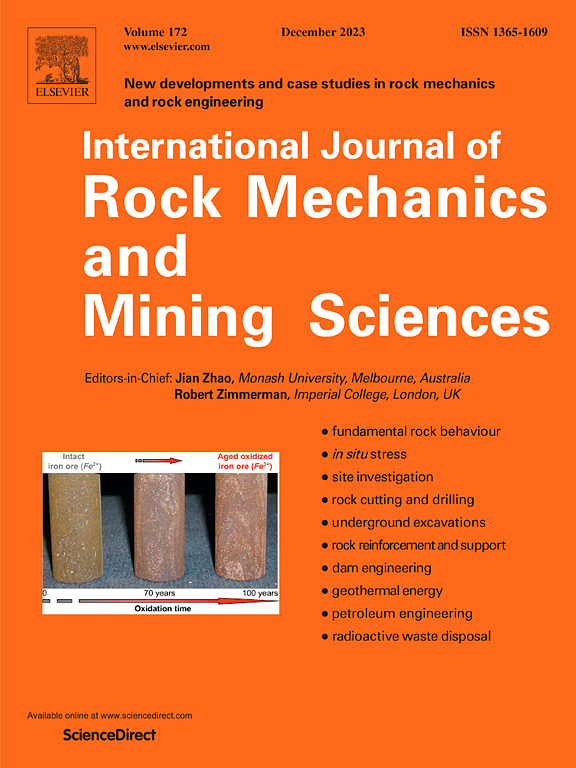岩石直接拉伸破坏的声发射演化及破裂机制
IF 7
1区 工程技术
Q1 ENGINEERING, GEOLOGICAL
International Journal of Rock Mechanics and Mining Sciences
Pub Date : 2024-11-29
DOI:10.1016/j.ijrmms.2024.105974
引用次数: 0
摘要
工程岩体的破坏机制主要包括拉伸破坏和剪切破坏。区分岩石拉伸和剪切损伤过程中产生的声发射信号,可以为现场岩石破裂监测中声信号的分类提供科学依据。本文对花岗岩直接拉伸试验中的声发射监测进行了研究,提出了一种基于试样损伤破坏过程的声发射信号分类方法。此外,还探讨了拉伸和剪切声发射信号的分类。主要结论如下:低频信号(频率<;200 kHz)和高频信号(频率>;200 kHz)在所有声发射信号中所占的比例分别为81.6%和19.4%。根据岩石拉伸破坏声发射信号综合分类统计方法,即“原始波形去噪、时频域数据变换、模糊化处理、优势频率及其对应幅值提取、次优势频率识别”,将声发射信号分为A、B两类。A类信号平均占7.6%,B类信号平均占92.4%。基于极性确定方法,确定了声发射事件的震源机制。在拉伸事件中,A类信号的平均比例为8.34%,B类信号的平均比例为91.66%。巴西劈裂试验也得到了与直接拉伸试验相似的分类结果。因此,初步得出A型信号为剪切信号,同时存在主频和次频,而B型信号为拉伸信号,只有主频而没有次频。本文章由计算机程序翻译,如有差异,请以英文原文为准。
Acoustic emission evolution and fracture mechanism of rock for direct tensile failure
The failure mechanisms of engineering rock masses primarily involve tensile and shear failure. Differentiating between the acoustic emission (AE) signals generated during the tensile and shear damage processes in rock can provide a scientific basis for the classification of acoustic signals in field rock fracture monitoring. This paper presents a study on acoustic emission monitoring during the direct tensile testing of granite, proposing a method for classifying AE signals based on the damage and failure processes of the samples. Additionally, the classification of tensile and shear AE signals is explored. The main conclusions are as follows. The proportion of low-frequency signals (frequency <200 kHz) and high-frequency signals (frequency >200 kHz) in all AE signals was found to be 81.6 % and 19.4 %, respectively. Based on an integrated classification and statistical method for AE signals in rock tensile failure, which involves steps such as “denoising the raw waveform, time-frequency domain data transformation, fuzzification processing, extraction of dominant frequency and corresponding amplitude, and identification of secondary dominant frequencies,” the AE signals were categorized into two types, A and B. Type A signals accounted for an average of 7.6 %, while Type B signals made up 92.4 %. Based on the polarity determination method, the focal mechanisms of AE (Acoustic Emission) events were identified. In tensile events, the average proportion of Type A signals was 8.34 %, while the average proportion of Type B signals was 91.66 %. The Brazilian splitting test also yielded classification results similar to those obtained from direct tensile testing. Thus, it was preliminarily concluded that Type A signals, characterized by the presence of both a primary and secondary frequency, correspond to shear signals, whereas Type B signals, which only exhibit a primary frequency without a secondary frequency, correspond to tensile signals.
求助全文
通过发布文献求助,成功后即可免费获取论文全文。
去求助
来源期刊
CiteScore
14.00
自引率
5.60%
发文量
196
审稿时长
18 weeks
期刊介绍:
The International Journal of Rock Mechanics and Mining Sciences focuses on original research, new developments, site measurements, and case studies within the fields of rock mechanics and rock engineering. Serving as an international platform, it showcases high-quality papers addressing rock mechanics and the application of its principles and techniques in mining and civil engineering projects situated on or within rock masses. These projects encompass a wide range, including slopes, open-pit mines, quarries, shafts, tunnels, caverns, underground mines, metro systems, dams, hydro-electric stations, geothermal energy, petroleum engineering, and radioactive waste disposal. The journal welcomes submissions on various topics, with particular interest in theoretical advancements, analytical and numerical methods, rock testing, site investigation, and case studies.

 求助内容:
求助内容: 应助结果提醒方式:
应助结果提醒方式:


